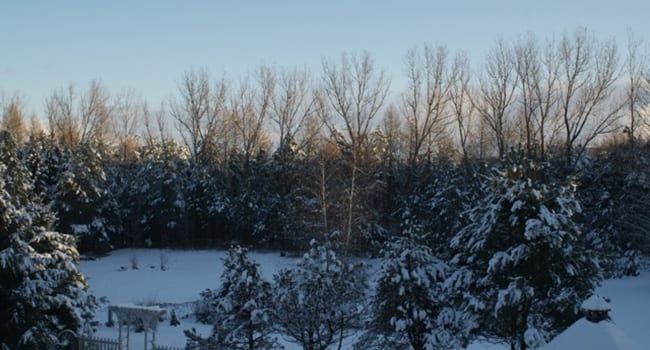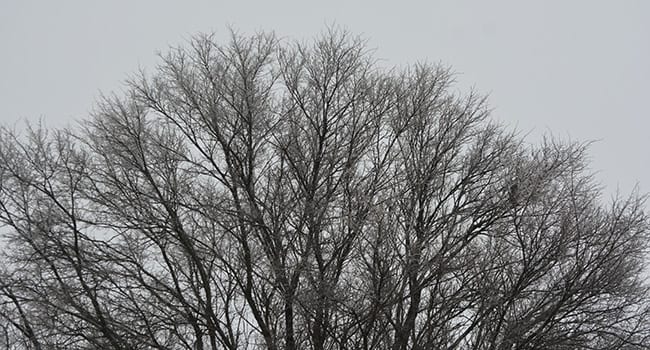
At the beginning of winter, trees are in a state of dormancy after losing their leaves in the fall and reducing the production of food, restricting the transport of nutrients and water. Photo by Geoff Carpentier
 Every year about this time, I get quite excited as my trees start to get chubby!
Every year about this time, I get quite excited as my trees start to get chubby!
They aren’t really putting on weight, but their profile looks different than it did in November and December, when it was easy to see the sky through the branches since the buds were very small and the twigs weren’t swollen.
In January as the days get longer, the trees start preparing for spring and the buds start to swell, making the tree look fuller and ‘fatter.’
The trees I use for this annual determination are the poplars that grow at the back of my property. I like them because I can easily compare the density of the twigs against the sky as the days pass.
So what exactly is going on?
The trees have been in a state of dormancy for weeks after losing their leaves in the fall and otherwise reducing the production of food, and restricting the transport of nutrients and water throughout the plant. Ironically, native trees need to go through a prolonged period of exposure to low temperatures (i.e. -5C to 10C) so the new growth can develop in the spring.
Just to complicate it, some species that grow in both cold and more temperate climates differ physiologically such that the southern forms don’t need to freeze while the northern ones do. But let’s not worry about that because all our native plants in Durham, Ont., must go through this freeze cycle to survive.
Native trees have adapted such that they’re synchronous with the annual temperature cycles in their geographic area or zone, as it’s called by gardeners.
Trees are adapted to withstand freezes and thaws and the timing of bud break is controlled mostly by the amount of daylight and to a lesser degree by the ambient temperature. If this wasn’t the case, then every year when we have a January thaw, the buds would burst, leaves would emerge and then be killed by the returning freezing temperatures.
Since buds are formed the previous summer, this would be fatal to the tree as new buds can’t be regrown in the spring.
In the north, as the days lengthen and the soil slowly warms, the balance of enzymes and hormones that promote growth within the tree is altered and bud development is stimulated long before bud break occurs and leaves emerge, or flush as it’s called.
Buds break after varying periods of freezing, but generally here the aspen is the earliest, the maple and beech somewhere in the middle and white ash the latest.
But what actually prevents the buds from reacting too soon after a prolonged thaw?
It has to do with the physiology of the plants. The overwintering buds are really a conglomeration of “miniature shoots with apical meristems, leaf primordia and axillary buds, the whole enclosed by several modified leaves called bud scales.”
Huh?
That really just means that all the elements that are necessary for growth in the summer are present in these tiny buds. Each is protected by bud scales that defend against mechanical injury, provide insulation, restrict gas exchange and prevent desiccation. That’s a lot of tasks for such a tiny bud.
In the spring, the growth is reactivated when environmental conditions suitable for growth stimulate the plant. External stimuli, combined with internal plant hormones and enzymes, ensure that the renewal of growth occurs at the most favorable time.
As climate change advances and temperatures continue to rise, our trees are not in immediate jeopardy unless the chilling periods are reduced to a length that interrupts the dormancy cycle too greatly. Trees are adaptable but only to a certain point.
Complicating this is the variation in the wet/dry cycles trees must face. These can be equally devastating to our native trees.
But for now all is well and my trees are plumping up nicely!
Geoff Carpentier is a published author, expedition guide and environmental consultant.

In January as the days get longer, the trees start preparing for spring and the buds start to swell, making the tree look fuller and ‘fatter.’ Photo by by Geoff Carpentier
Geoff Carpentier is a published author, expedition guide and environmental consultant. Visit Geoff online at www.avocetnatureservices.com, on LinkedIn and on Facebook.
The views, opinions and positions expressed by columnists and contributors are the author’s alone. They do not inherently or expressly reflect the views, opinions and/or positions of our publication.

